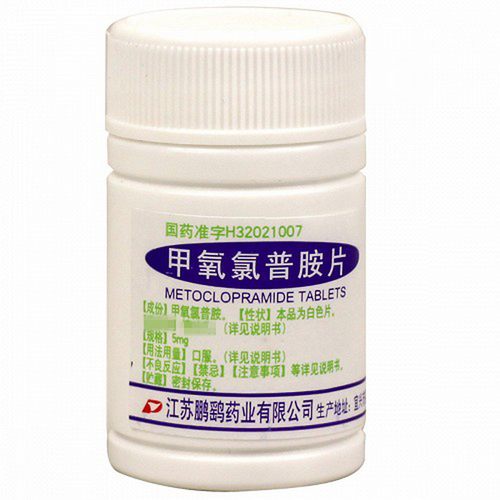Product Overview
[Drug Name]
Trade Name: Fenhe
English Name: Metoclopramide Tablets
Chinese Pinyin: Jiayang Lüpu'an Pian
[Main Ingredient]
Metoclopramide.
[Properties]
This product is a white tablet.
[Indications]
Antiemetic. Primarily used for the symptomatic treatment of nausea, vomiting, belching, indigestion, gastric distension, and hyperacidity caused by various etiologies; 2. Reflux esophagitis, bile reflux gastritis, functional gastric retention, and gastroptosis; 3. Delayed emptying of the residual stomach and delayed gastric emptying after vagotomy; 4. Gastric emptying disorders caused by collagen disorders such as diabetic gastroparesis, uremia, and scleroderma.
[Dosage and Administration]
Oral. Adults: 5-10 mg three times a day. For patients with diabetic gastric emptying dysfunction, administer 10 mg orally 30 minutes before symptom onset; or 5-10 mg four times daily before meals and bedtime. The total adult dose should not exceed 0.5 mg/kg/day. Children: 5-14 years old, 2.5-5 mg three times daily, 30 minutes before meals, preferably for short periods. The total pediatric dose should not exceed 0.1 mg/kg/day.
[Adverse Reactions]
1. Common adverse reactions include drowsiness, restlessness, and fatigue; 2. Less common reactions include breast tenderness, nausea, constipation, rash, diarrhea, sleep disturbances, dizziness, severe thirst, headache, and irritability; 3. Increased milk production may occur during treatment due to prolactin stimulation; 4. Long-term use of high doses may block dopamine receptors, leading to relative hyperactivity of cholinergic receptors and extrapyramidal reactions (especially in young people), which may include muscle tremors, dysarthria, and ataxia.
【Contraindications]
1. The following conditions preclude its use: (1) Hypersensitivity to procaine or procainamide; (2) Increased frequency and severity of seizures due to medication; (3) Increased gastrointestinal motility and worsening of the condition due to medication in cases of gastrointestinal bleeding, mechanical intestinal obstruction, or perforation; (4) Hypertensive crisis due to medication in patients with pheochromocytoma; (5) Not for use in breast cancer patients experiencing vomiting due to chemotherapy or radiotherapy. 2. Use with caution in the following conditions: (1) Liver failure, resulting in loss of protein binding capacity; (2) Renal failure, i.e., severe chronic renal failure, increases the risk of extrapyramidal reactions, and the dosage should be reduced.
[Precautions]
1. Aldosterone and serum prolactin concentrations may increase with the use of metoclopramide; 2. The dose should be reduced by at least 60% in patients with severe renal insufficiency, as these patients are prone to extrapyramidal symptoms; 3. Because this product can reduce the oral bioavailability of cimetidine, if the two drugs must be used together, the interval should be at least 1 hour; 4. The toxicity of this product increases after it turns yellow or yellowish-brown upon exposure to light.
[Special Populations]
Children: Not suitable for long-term use in children.
Pregnancy and Lactation: Potential teratogenic effects; not suitable for pregnant women; can be used for short periods to promote lactation in lactating women with insufficient milk production.
Elderly: Elderly individuals should not use this product in large doses for extended periods, otherwise extrapyramidal symptoms may occur.
[Drug Interactions]
1. When used concurrently with acetaminophen, levodopa, lithium compounds, tetracycline, ampicillin, ethanol, and diazepam, gastric emptying is accelerated, leading to increased absorption of the latter in the small intestine; 2. Concurrent use with ethanol or central nervous system depressants enhances the sedative effect; 3. There is an antagonistic effect when used with anticholinergic drugs and anesthetic analgesics; 4. When used with antimuscarinic anesthetic sedatives, the motility of metoclopramide in the gastrointestinal tract can be negated; 5. Due to its ability to release catecholamines, it should be monitored in hypertensive patients currently using monoamine oxidase inhibitors; 6. Concurrent use with acetaminophen, tetracycline, and levodopa...
[Pharmacological Actions]
This product is a dopamine 2 (D2) receptor antagonist and also has an agonist effect on the 5-HT4 (5-HT4) receptor, and a mild inhibitory effect on the 5-HT3 receptor. It acts on dopamine receptors in the medullary chemo-emetic zone (CTZ), raising the CTZ threshold and exerting a potent central antiemetic effect. It also blocks hypothalamic dopamine receptors, inhibiting prolactin inhibitory factor and promoting prolactin secretion, thus exerting a certain galactagogue effect. Its inhibitory effect on other central nervous system sites is minimal, resulting in a weak sedative effect and less hypnotic effect. Its gastrointestinal effects primarily target the upper gastrointestinal tract, promoting motility in the stomach and upper intestine. It also increases resting gastrointestinal sphincter tone, increasing the tone and contraction amplitude of the lower esophageal sphincter, and thus increasing lower esophageal pressure.
[Storage]
Store tightly sealed.
[Specifications]
5mg x 100 tablets
[Expiry Period]
36 months
[Approval Number]
National Medicine Standard H14021025
[Manufacturer]
Company Name: Shanxi Fenhe Pharmaceutical Co., Ltd.










